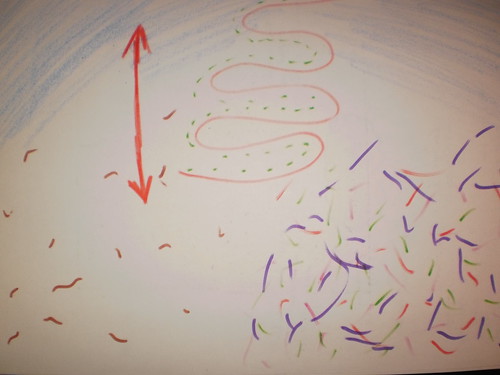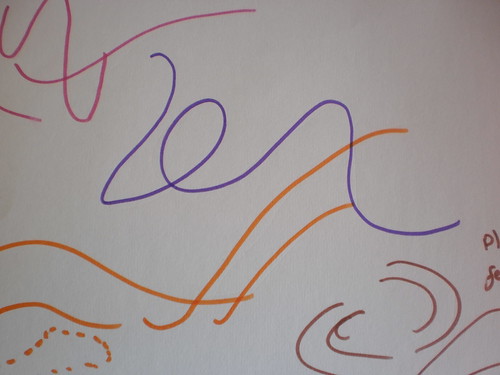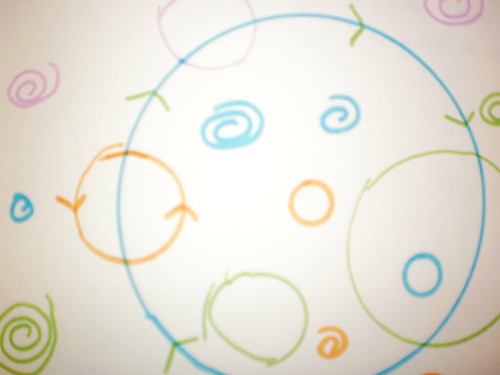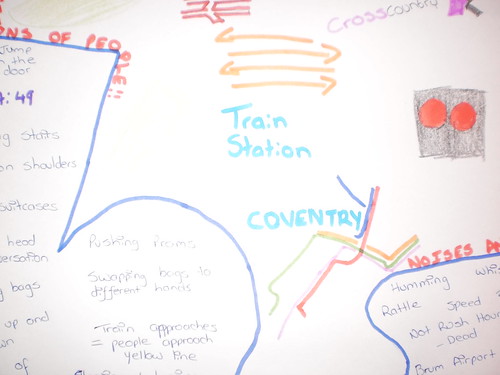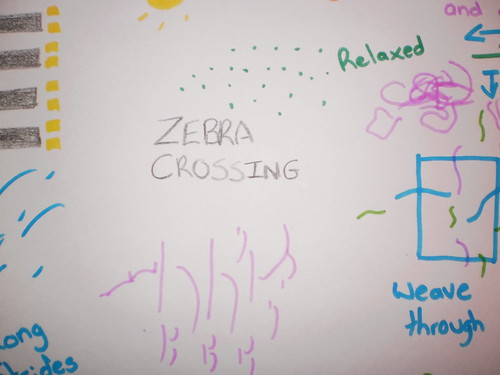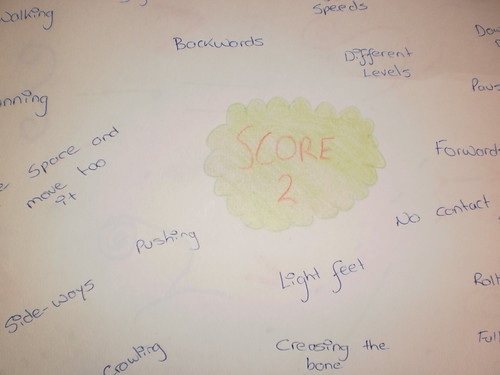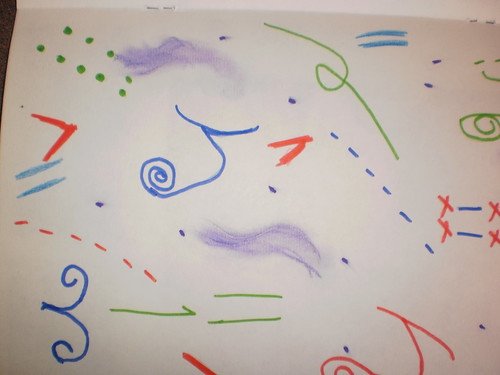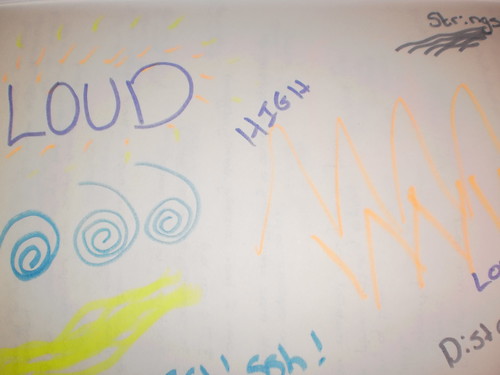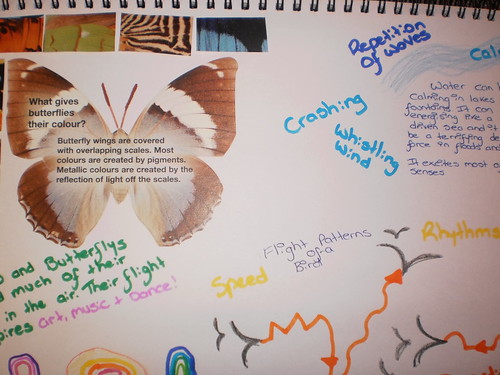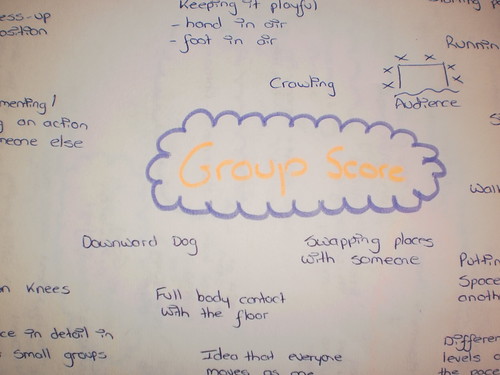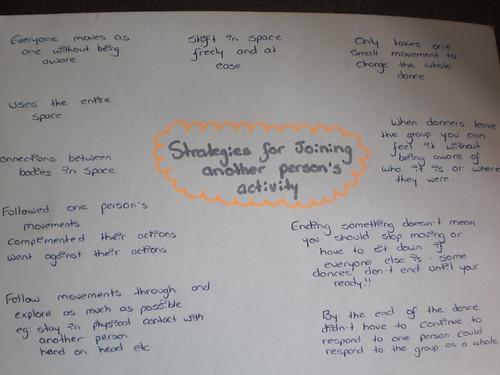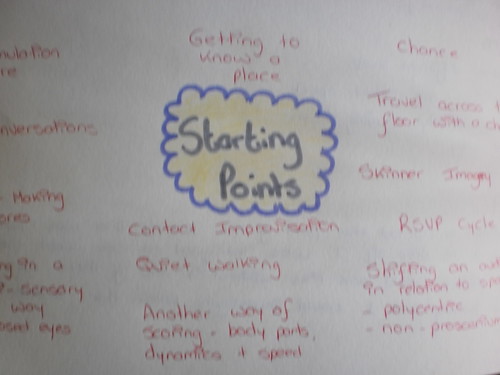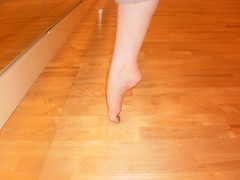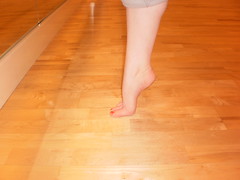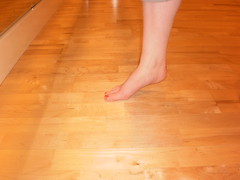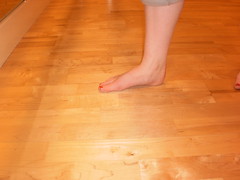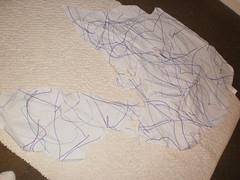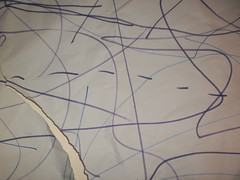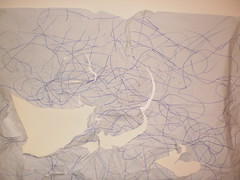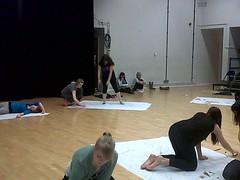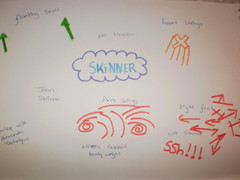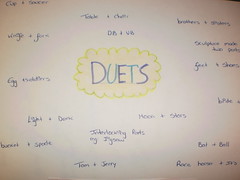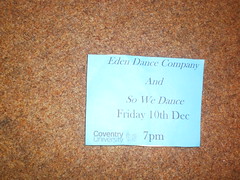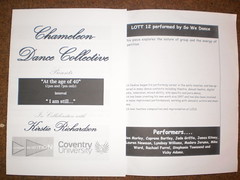Thursday 22 December 2011
Monday 19 December 2011
Travelling Across The Floor
Spine felt independent to the rest of the body
Curling and uncurling of the spine
Head and tail leading
Space inbetween bones
Imagry of the spine moving as a snake
Rolling and curling on the floor
Head moving in different directions helped to take me in and out of the floor
Used breath to move into each moment
Could start a new journey each time I moved in and out of the floor
Finished each time with a rolling up of the body
Used the head to lead more than the tail
Brought more awareness to my spine than I would have on a normal basis
When the body uncurls, head hanging over the body it puts extra pressure on the knees and feels uncomfortable if the knees are not fully bent.
Curling and uncurling of the spine
Head and tail leading
Space inbetween bones
Imagry of the spine moving as a snake
Rolling and curling on the floor
Head moving in different directions helped to take me in and out of the floor
Used breath to move into each moment
Could start a new journey each time I moved in and out of the floor
Finished each time with a rolling up of the body
Used the head to lead more than the tail
Brought more awareness to my spine than I would have on a normal basis
When the body uncurls, head hanging over the body it puts extra pressure on the knees and feels uncomfortable if the knees are not fully bent.
On Alert
I have a close friend who is a Vietnam veteran. He described to me how he often chose to "walk point" when he was in the field. This lead position for a foot solider was a likely place to be killed or injured by a mine or a surprise attack. He worried that someone would get killed, so he preferred to be in the position himself. His spine never relaxed in nine months of active duty. Now he has severe spasms in his back. His work with vet groups and in therapy has begun to release the tensions from the experiences of war. Yet even a small disturbance can result in a feeling of being on guard and a rigid spine. The more his capacity for relaxation increases, the more extreme the spasms. He is feeling the pain.
Axial Skeleton:Skull to Spine
The axial skeleton includes the skull, the spine, the "rib-cage" and the free floating hyoid bone.
The weight transfer from the skull to the spine is key to postural alignment.
It travels down the bodies of the vertebrae, spreads around the bone of the pelvis through the sacrum, and is transferred to the ground through the legs and feet.
The spinal cord hangs like a tail from the brain, the skull sits on the atlas, transferring its weight anterior to the cord.
The atlas is the only vertebra which can be moved independently from the rest of the spine. The skull can rock forward and backward around its horizontal axis making a "yes" nod.
Like a snake, movement of the spine travles collectively and rhythmically through the whole structure.
Our spine is a progression of alternating curves.
In postural alignment, balance of the spine lives in the mobility of its opposing curves.
Our goal is to have a responsive spine, not a "straight" spine.
The structure of the spine allows 3D mobility so that we can move through the three planes of movement
The weight transfer from the skull to the spine is key to postural alignment.
It travels down the bodies of the vertebrae, spreads around the bone of the pelvis through the sacrum, and is transferred to the ground through the legs and feet.
The spinal cord hangs like a tail from the brain, the skull sits on the atlas, transferring its weight anterior to the cord.
The atlas is the only vertebra which can be moved independently from the rest of the spine. The skull can rock forward and backward around its horizontal axis making a "yes" nod.
Like a snake, movement of the spine travles collectively and rhythmically through the whole structure.
Our spine is a progression of alternating curves.
In postural alignment, balance of the spine lives in the mobility of its opposing curves.
Our goal is to have a responsive spine, not a "straight" spine.
The structure of the spine allows 3D mobility so that we can move through the three planes of movement
Friday 16 December 2011
Thoughts on Frame Task
I chose to work with the frames of my desk in my bedroom. I began lying on the floor with my eyes closed, but quickly came to move around the floor until I was next to the desk.
I slowly investigated how the desk fet by using my sensoury awareness of touch. The four leg stands felt cold on my hands and feet, but it felt refreshing against the warm temperature in my room and provided me with a creative boost of energy to explore the frame in more depth.
The desk seemed inviting as a result of its smooth surfaces, amd therefore I found many ways to enter in and out of the frame through rolling, crawling and sliding through the bars frontwards and backwards. The room seemed bigger from under the desk and brighter too.
I came out of the desk and began to look at it from different angles: downward dog, on all four's, upward dog. I sat with my back against one of the legs and acted as a support for the desk. I was surprised to find that in giving my weight to the bars they actually supported me.
I slowly investigated how the desk fet by using my sensoury awareness of touch. The four leg stands felt cold on my hands and feet, but it felt refreshing against the warm temperature in my room and provided me with a creative boost of energy to explore the frame in more depth.
The desk seemed inviting as a result of its smooth surfaces, amd therefore I found many ways to enter in and out of the frame through rolling, crawling and sliding through the bars frontwards and backwards. The room seemed bigger from under the desk and brighter too.
I came out of the desk and began to look at it from different angles: downward dog, on all four's, upward dog. I sat with my back against one of the legs and acted as a support for the desk. I was surprised to find that in giving my weight to the bars they actually supported me.
Sunday 4 December 2011
Saturday 3 December 2011
Frame Task
Create a frame for yourself
Find a place to view from
Observe entrances and exits
Like a camera:Zooming in, zooming out, in focus, out of focus, playing with the depth of field
Record experience in some way
Find a place to view from
Observe entrances and exits
Like a camera:Zooming in, zooming out, in focus, out of focus, playing with the depth of field
Record experience in some way
Thursday 1 December 2011
Bench Task Observations
I found myself reluctant to close my eyes, so I put my head down instead
Contrast between busy atmosphere and quiet nature
Sense of a community
Voices and conversations trailing off into the distance
Sound of different rhythms creating by people walking up and down the steps
Felt an urge to get involved in other people's conversations
opening and closing of automatic door
Industrial building vs Nature surrounding it
Contrast between busy atmosphere and quiet nature
Sense of a community
Voices and conversations trailing off into the distance
Sound of different rhythms creating by people walking up and down the steps
Felt an urge to get involved in other people's conversations
opening and closing of automatic door
Industrial building vs Nature surrounding it
Bench Task
Solo task:
Find a bench loaction-take a 15 minute timed rest-with eyes closed.
Keep attentive the musicality, the 3D sound score as well as notice the curiousity, the distractions, your stillness and your restlessness. What resonates for you?
Create a musical impression in words, pictures, symbols, song etc that can capture/record this moment in time
Find a bench loaction-take a 15 minute timed rest-with eyes closed.
Keep attentive the musicality, the 3D sound score as well as notice the curiousity, the distractions, your stillness and your restlessness. What resonates for you?
Create a musical impression in words, pictures, symbols, song etc that can capture/record this moment in time
Monday 28 November 2011
Up Until Now
"When I see a dancer seeing, I see them absolutely free of their habitual behaviour, I see them absolutely affected by their visual field, and so the surprises are endless."
"To celebrate the endless possibilities if we could just learn to let go of what we think we want"
The idea of noticing a moment and moving onto the next, without holding onto one thing.
To be a participant in life without grasping and continuing to hold. To learn not to grasp.
The idea of not being afraid of what you don't know.
"To celebrate the endless possibilities if we could just learn to let go of what we think we want"
The idea of noticing a moment and moving onto the next, without holding onto one thing.
To be a participant in life without grasping and continuing to hold. To learn not to grasp.
The idea of not being afraid of what you don't know.
Lightening
How do I choreograph a piece?
I'm not trying to tell a story, or say what it is
I'm trying to find out what the dance is, once I teach it to the dancers. Through their performance I learn the fine tuning of the sketch that I come in with.
Space plays a big role in terms of the performance of the movement
Space, time, self and audience are the ingredients I work with in terms of the performance of the choreographed material
There is no time to improvise in my piece. The dancers are given so much to notice
Lightening is a play on words. I'm devoted to using language to excite the imagination.
They make choreographic choices about space and time within the performance of my dances.
I'm not trying to tell a story, or say what it is
I'm trying to find out what the dance is, once I teach it to the dancers. Through their performance I learn the fine tuning of the sketch that I come in with.
Space plays a big role in terms of the performance of the movement
Space, time, self and audience are the ingredients I work with in terms of the performance of the choreographed material
There is no time to improvise in my piece. The dancers are given so much to notice
Lightening is a play on words. I'm devoted to using language to excite the imagination.
They make choreographic choices about space and time within the performance of my dances.
Sunday 27 November 2011
Walking Within
.eerie opening atmosphere
.Found the lighting interesting at the start of the piece. I liked the shapes that it created
.Use of paper score
.Interaction with audience members
.Movement was very fluid and covered a range of space
.I found the use of film didn't really interest me at the beginning and I tended to ignore it and watch the movement that was being created instead. However, it grabbed my attention when it almost told a story and helped to create a chaotic and at times claustrophobic atmosphere.
A journey
with boundaries
and transitions
Observing
Listening
A commentary
A fiction
Life like
www.walkingwithin.com
.Found the lighting interesting at the start of the piece. I liked the shapes that it created
.Use of paper score
.Interaction with audience members
.Movement was very fluid and covered a range of space
.I found the use of film didn't really interest me at the beginning and I tended to ignore it and watch the movement that was being created instead. However, it grabbed my attention when it almost told a story and helped to create a chaotic and at times claustrophobic atmosphere.
A journey
with boundaries
and transitions
Observing
Listening
A commentary
A fiction
Life like
www.walkingwithin.com
Andrea Buckley Research
Andrea Buckley works as an independent dance artist, whose experience extends over 20 years, performing teaching and creating work in various professional contexts to include the wider community.
Her primary research draws upon an extensive range of improvisation and contact skills as a way to continue to develop an awareness of the moving body and expand a repertoire of composition.
She has performed with many independent artists touring UK, Ireland, Europe and parts of America. These include; Kirstie Simson, Nancy Stark–Smith, MacLennan Dance & Company, Rosemary Lee, Gill Clarke and Deborah Hay.
Committed to work happening in the North West Andrea is part of an artist led initiative, Liverpool Improvisation Collective (LIC) - initiating workshops, festivals and performance projects - they have a designated artist led space at the Bluecoat, Liverpool.
Presently as well as working with Siobhan Davies Dance, she is developing her own performance project Walking Within - Episode II in collaboration with film artist Dan Williams and Composer/musician Jamie McCarthy.
Her primary research draws upon an extensive range of improvisation and contact skills as a way to continue to develop an awareness of the moving body and expand a repertoire of composition.
She has performed with many independent artists touring UK, Ireland, Europe and parts of America. These include; Kirstie Simson, Nancy Stark–Smith, MacLennan Dance & Company, Rosemary Lee, Gill Clarke and Deborah Hay.
Committed to work happening in the North West Andrea is part of an artist led initiative, Liverpool Improvisation Collective (LIC) - initiating workshops, festivals and performance projects - they have a designated artist led space at the Bluecoat, Liverpool.
Presently as well as working with Siobhan Davies Dance, she is developing her own performance project Walking Within - Episode II in collaboration with film artist Dan Williams and Composer/musician Jamie McCarthy.
Performance Project
This term as part of our performance project module, I get the opportunity to work with independent dance artist and choreographer Andrea Buckley. I am looking forward to the process of working towards a final piece of work and developing many new skills along the way. As a result of Andrea working mainly with improvisation and contact work, I know that this will be a huge challenge for me as these are two areas that I still don't feel entirely confident in just yet. I hope that the five day dance intensive will create an opportunity for me to question and explore my process as a dancer and will help me in becoming more confident in how I perform.
Pelvis Awareness
Points of Focus:
1.Longer strides help to emphasise the fact that it moves from left to right
2.Using the breath feel it dip "like a hiccup" and let it take you up into the air
3.Try it with a spiral and on alternative sides
1.Longer strides help to emphasise the fact that it moves from left to right
2.Using the breath feel it dip "like a hiccup" and let it take you up into the air
3.Try it with a spiral and on alternative sides
Movement Transitions
Points of focus:
1.Sending energy out into space
2.Watching where the skull is in relation to the rest of the body
3.Rocking backwards and forwards, using hands and feet to take the pressure. Remember to keep the spine easy and soft.
1.Sending energy out into space
2.Watching where the skull is in relation to the rest of the body
3.Rocking backwards and forwards, using hands and feet to take the pressure. Remember to keep the spine easy and soft.
Friday 25 November 2011
Witnessing Movement
.Fuid movements
.Equal input of words-nice to hear different languages
.Consistently worked on the floor
.All seemed to move at the same pace
.Movements really stretch out and use the avaliable space
.Change of pace from walk to run
.Investigation takes place before the next word is thrown in
.Possibility to reject the instruction
.Equal input of words-nice to hear different languages
.Consistently worked on the floor
.All seemed to move at the same pace
.Movements really stretch out and use the avaliable space
.Change of pace from walk to run
.Investigation takes place before the next word is thrown in
.Possibility to reject the instruction
Movement With Words
Floats Continuious Glance Glee Pleasure
Host Stars Dance Company Daffodils
Golden Stretched Waves Pensive
Fluid Small Floor Water
Host Stars Dance Company Daffodils
Golden Stretched Waves Pensive
Fluid Small Floor Water
Poem Choice
I've always had an interest in this poem as it was introduced to me at a very young age when the description of dancing in relation to nature grabbed my attention. I also liked the idea that an image that is so simple, and yet one that we often take for granted, could bring the poet so much joy and as a result often take away the pain of lonliness.
If I Could Write Words
If I could write words
Like leaves on an autumn forest floor
What a bonfire my letters would make
If I could speak words of water,
You would drown when I said
"I love you"
Like leaves on an autumn forest floor
What a bonfire my letters would make
If I could speak words of water,
You would drown when I said
"I love you"
Daffodils- William Wordsworth
I wondered lonely as a cloud
That floats on high o'er vales and hills
When all at once I saw
A host, of golden daffodils;
Beside the lake, beneath the trees
Fluttering and dancing in the breeze
Continuous as the stars that shine
And twinkle on the milky way,
They stretched in never-ending line
Along the margin of a bay:
Ten thousand saw I at a glance,
Tossing their heads in sprightly dance
The waves beside them danced, but they
Out-did the sparkling waves in glee:
A poet could not but be gay,
In such a jocund company:
I gazed-and gazed-but little thought
What wealth the show to me had brought
For oft, when on my couch I lie
In vacant or in pensive mood,
They flash upon that inward eye
Which is the bliss of solitude;
And then my heart with pleasure fills,
And dances with the daffodils
That floats on high o'er vales and hills
When all at once I saw
A host, of golden daffodils;
Beside the lake, beneath the trees
Fluttering and dancing in the breeze
Continuous as the stars that shine
And twinkle on the milky way,
They stretched in never-ending line
Along the margin of a bay:
Ten thousand saw I at a glance,
Tossing their heads in sprightly dance
The waves beside them danced, but they
Out-did the sparkling waves in glee:
A poet could not but be gay,
In such a jocund company:
I gazed-and gazed-but little thought
What wealth the show to me had brought
For oft, when on my couch I lie
In vacant or in pensive mood,
They flash upon that inward eye
Which is the bliss of solitude;
And then my heart with pleasure fills,
And dances with the daffodils
Sunday 13 November 2011
Group Work
Working in groups of four we had to "look for the spaces" inbetween each other. This required seeing the space at all times and having a sense of where each of us where in the space. My feet and knees had to be soft and supple in order to move quickly and to be ready for surprise movements. Balance was also needed to start and stop abruptly. Adding onto the score we played with the idea of one person always standing and one person always being on a low level. This required extra concentration to see what other people in the group were doing.
The main difference in working with a larger group was the higher level of energy and creativity. It was interesting to watch everyone in the space at the same time and how that compared with only a few people in the space.
The main difference in working with a larger group was the higher level of energy and creativity. It was interesting to watch everyone in the space at the same time and how that compared with only a few people in the space.
Amy's Improvisation Class
As a warm up exercise we began on the floor and gave thought to the skull and where it was in relation to space. With this is mind we began to roll with the head leading. I find it easier to lead with the head on the floor as opposed to the pelvis because it feels heavier and therefore I can become more aware of the direction it wants to travel in. We then introduced the idea of using the hands and feet to take us in and out of the floor, with the head continuing to lead. This helped me to explore more with transitions from lying, to sitting, to standing. I noticed that as I roll my head up I tend to move the last few vertabres very slowly as they tend to feel more fragile and less protected.
I moved towards a partner with my eyes closed and placed my feet against theirs. Playing with giving and taking weight, I noticed that when I pushed against my partner she didn't move but when she pushed against me I had to use all my support and strength in my legs to resist. Even then, I found myself slipping across the floor. We explored the idea of having our heads always connected and I found this easier as it created a stronger sense of connection and the transitions in and out of the floor were more fluid.
I moved towards a partner with my eyes closed and placed my feet against theirs. Playing with giving and taking weight, I noticed that when I pushed against my partner she didn't move but when she pushed against me I had to use all my support and strength in my legs to resist. Even then, I found myself slipping across the floor. We explored the idea of having our heads always connected and I found this easier as it created a stronger sense of connection and the transitions in and out of the floor were more fluid.
Thursday 10 November 2011
What is Proccess?
To be in the middle or midst of something
Putting lessons and knowledge into practice
A never-ending development
Constant Learning
Continue to Witness/observe your own development
Feeling in a moment
Letting go of end-gaining, and enjoying being in the moment.
As a dancer I feel that I am always in a process of creating my skills both physically and creativly. I have found over the past year that learning to become patient with my development is also a process in itself.
Putting lessons and knowledge into practice
A never-ending development
Constant Learning
Continue to Witness/observe your own development
Feeling in a moment
Letting go of end-gaining, and enjoying being in the moment.
As a dancer I feel that I am always in a process of creating my skills both physically and creativly. I have found over the past year that learning to become patient with my development is also a process in itself.
Sunday 20 March 2011
Points Of Focus
1. Fluidity of movement transitions
2. Maintain strong arms at the beginning
3. Running in sync
4. Could we possibly make it longer?
2. Maintain strong arms at the beginning
3. Running in sync
4. Could we possibly make it longer?
Work In Progress Feedback
During our work In Progress sharing I felt that myself and my partner had created a thought provking and detailed research, however we hadn't completely captured that detail into our studio rehersals just yet. As a result, any feedback that was to be given was essential for our work to continue to develop further.
Comments from the floor:
Repetition is really clear
Running could be more powerful
Explore the idea of falling into the running because it's quite static
Think about where you place the audience and which directions you face them
Comments from Kayte:
Play with the idea of a narrower runway to enhance the repetition
Pathways are clear, but could become stronger
Embody the material and what the memory is your playing with
Create a better connection with the ground
Don't use material from class phrases
My role as a dancer needs to be stronger
Comments from the floor:
Repetition is really clear
Running could be more powerful
Explore the idea of falling into the running because it's quite static
Think about where you place the audience and which directions you face them
Comments from Kayte:
Play with the idea of a narrower runway to enhance the repetition
Pathways are clear, but could become stronger
Embody the material and what the memory is your playing with
Create a better connection with the ground
Don't use material from class phrases
My role as a dancer needs to be stronger
Thursday 17 March 2011
Improvisation Class
We had an Improvisation class at the start of term that really gave me some food for thought! I was given some words that really feed into dance that I hope to remember when I perform and choreograph.
1. Empowerment
2. Passion
3. Inclusion
4. Celebrating the individual
5. Translate
6. Facilitate
7. Creative
We were also asked two questions that really made me think about the way in which I move.
What stops you, what blocks you and why?
After creating a very short improvisation I found that what stops me from really exploring as much as possible is the lack of space that we have in the smaller studios. I find myself constantly having to be aware that I don’t stand on someone’s hand or foot, and that I’m not taking up too much space either. As a result I can’t travel as freely as I would like to do.. What really surprised me about this improvisation was that when we were asked to move with a partner I really would have preferred to work on my own. This is definitely a new feeling for me, as I normally enjoy having another person to bounce off. I hope this means that I’m becoming more comfortable within my own movements and have a stronger need to explore them.
What do you celebrate about your dance and what do you need to do to feed it in your practice?
I am slowly beginning to appreciate the simplicity of my movements as I think this allows me to be more creative in what I do as I’m not overly concerned about making things look “pretty”. I think I can feed this into my practice by continuing at a steady place and not rushing movement transitions.
1. Empowerment
2. Passion
3. Inclusion
4. Celebrating the individual
5. Translate
6. Facilitate
7. Creative
We were also asked two questions that really made me think about the way in which I move.
What stops you, what blocks you and why?
After creating a very short improvisation I found that what stops me from really exploring as much as possible is the lack of space that we have in the smaller studios. I find myself constantly having to be aware that I don’t stand on someone’s hand or foot, and that I’m not taking up too much space either. As a result I can’t travel as freely as I would like to do.. What really surprised me about this improvisation was that when we were asked to move with a partner I really would have preferred to work on my own. This is definitely a new feeling for me, as I normally enjoy having another person to bounce off. I hope this means that I’m becoming more comfortable within my own movements and have a stronger need to explore them.
What do you celebrate about your dance and what do you need to do to feed it in your practice?
I am slowly beginning to appreciate the simplicity of my movements as I think this allows me to be more creative in what I do as I’m not overly concerned about making things look “pretty”. I think I can feed this into my practice by continuing at a steady place and not rushing movement transitions.
Wednesday 16 March 2011
White Man Sleeps
White Man Sleeps was choreographed for Siobhan Davies new company in 1988 and was a piece created for five dancers. However, over the years Davies has continued to rework this piece in order to achieve even further how she wanted the piece to look and feel.
The use of lighting and music in this piece really reflects the dancer’s movements. I think the dark lighting helps to emphasise each movement and the music creates an overall fluid feel to the dance as it performed to a string quartet. There is a strong use of repetition in this piece that is present in both the duets and group dances that helps to emphasise particular movements. The movement vocabulary mainly consists of strong leg movements, hand connections to the head, spirals and soft but fast feet movements. Throughout the piece the dancers come into contact with each other a lot of the time and this is particularly evident through the various lifts that Davies includes in this dance. I found it interesting to see how the dancers would work together in a group, but they would still be reflecting each others movements. This helped to focus on the movements that were being conveyed and it also emphasised the idea of repetition again in the dance.
Overall, I think this piece is interesting to watch because of the fluidity of the piece and the close relationships between the dancers.
The use of lighting and music in this piece really reflects the dancer’s movements. I think the dark lighting helps to emphasise each movement and the music creates an overall fluid feel to the dance as it performed to a string quartet. There is a strong use of repetition in this piece that is present in both the duets and group dances that helps to emphasise particular movements. The movement vocabulary mainly consists of strong leg movements, hand connections to the head, spirals and soft but fast feet movements. Throughout the piece the dancers come into contact with each other a lot of the time and this is particularly evident through the various lifts that Davies includes in this dance. I found it interesting to see how the dancers would work together in a group, but they would still be reflecting each others movements. This helped to focus on the movements that were being conveyed and it also emphasised the idea of repetition again in the dance.
Overall, I think this piece is interesting to watch because of the fluidity of the piece and the close relationships between the dancers.
Body Story Ideas
As I'm now starting to think about my body story, I have decided to investigate an hip injury that I've had for over 2 years which affects my movement on a daily basis.
In terms of the injury itself I am aware that over a period of time fluid has built up in my right hip socket which has lead to it becoming extremely tight and allowing minimal movement.
It has an effect on my dancing every day as I struggle with movemnets such as:
upside down movements
Rolls over the head
Movements initated from the pelvis
Yoga based exercises
leg swings in ballet class
In terms of the injury itself I am aware that over a period of time fluid has built up in my right hip socket which has lead to it becoming extremely tight and allowing minimal movement.
It has an effect on my dancing every day as I struggle with movemnets such as:
upside down movements
Rolls over the head
Movements initated from the pelvis
Yoga based exercises
leg swings in ballet class
Monday 14 March 2011
Improvisation Class
Score Rules:
Lean into the cirlce that you make
Change direction
Change speed
Pause
Go backwards
50 Acts-Wendy Houston
I found this piece of work interesting because of it's limited use of dance context in the way that most audienec memebers would know it best. Instead of using flowery and decorative movements, Houston stripped it back and used simple, everday movements to explore the theme of a spirited retaliation against ageism.
In her piece she used:
Random Acts
Small dances and big ideas
Invisibility
Ghostly apperances
Apologies and errors
Stupidity
In her piece she used:
Random Acts
Small dances and big ideas
Invisibility
Ghostly apperances
Apologies and errors
Stupidity
Wednesday 9 March 2011
Lea Anderson On Screen
As part of Nottingham Dance Festival we went to listen to a talk given by Lea Anderson on the relationship between choreography and film. She spoke about three different ways in which you can use film to create a piece of dance.
Flesh and Blood
This was the first time she had ever tried to use film as a starting point for choreography
Used Joan of Arc, the silent movie, as inspiration
Tried to remember what the film looked like in fast forward and therefore didn’t watch it back
Tried to embody something that she couldn’t completely remember, but still had a vague idea of the feeling it brought her.
Anderson didn’t play the video to any of the dancers as she wanted to commit to her imagination of what she remembered and then embody it.
Strong memory of head gestures which she conveyed in her choreography
Tried to look for a different movement vocabulary in flesh and blood, and she felt that the use of film really helped this
42nd Street
The movements that were created were taken exactly from the film. The only change was the mannerism in which the choreography was delivered.
Each dancer had to watch a particular dancer from the film and re-enact their movements
Anderson copied exact camera movements. For example, if there was a close up, only one dancer would remain on stage.
Believes that this was a “breakthrough in the idea of recycling work”
Would rather encourage dancers to try something new and observe other peoples movements as opposed to improvising.
Edits
Worked strongly with the idea of on and off stage
Found off stage choreography more difficult because of particular timings, such as taking off costumes
In this piece she was “looking for the invisible movement”
Found that the character became the costume rather than the person
Used two of the same character to create what was a mirror image of someone in a film
The three rectangles were used because the piece had to cut from close up to close up and therefore it was too difficult to emphasise that in the centre rectangle.
Flesh and Blood
This was the first time she had ever tried to use film as a starting point for choreography
Used Joan of Arc, the silent movie, as inspiration
Tried to remember what the film looked like in fast forward and therefore didn’t watch it back
Tried to embody something that she couldn’t completely remember, but still had a vague idea of the feeling it brought her.
Anderson didn’t play the video to any of the dancers as she wanted to commit to her imagination of what she remembered and then embody it.
Strong memory of head gestures which she conveyed in her choreography
Tried to look for a different movement vocabulary in flesh and blood, and she felt that the use of film really helped this
42nd Street
The movements that were created were taken exactly from the film. The only change was the mannerism in which the choreography was delivered.
Each dancer had to watch a particular dancer from the film and re-enact their movements
Anderson copied exact camera movements. For example, if there was a close up, only one dancer would remain on stage.
Believes that this was a “breakthrough in the idea of recycling work”
Would rather encourage dancers to try something new and observe other peoples movements as opposed to improvising.
Edits
Worked strongly with the idea of on and off stage
Found off stage choreography more difficult because of particular timings, such as taking off costumes
In this piece she was “looking for the invisible movement”
Found that the character became the costume rather than the person
Used two of the same character to create what was a mirror image of someone in a film
The three rectangles were used because the piece had to cut from close up to close up and therefore it was too difficult to emphasise that in the centre rectangle.
Dancing to different sounds
In our duets we picked a small piece of choreography that we had and performed it to three different types of sound. As a result, we found that each piece of sound somehow altered our dance and the way in which we performed it.
Tea For Two- Carlos Bica
Easy to follow my partner and stay in time with them
It was very easy to make the dance follow the rhythm given
Woodland Bird Song
Soundscape
Draws us out of our images and rhythms
Difficult to follow some type of rhythm
Aware of other sounds in the background
Didn’t tend to go at the same pace as my partner
Classical
Created the image of a garden party
Difficult to stay away from the rhythm
Tea For Two- Carlos Bica
Easy to follow my partner and stay in time with them
It was very easy to make the dance follow the rhythm given
Woodland Bird Song
Soundscape
Draws us out of our images and rhythms
Difficult to follow some type of rhythm
Aware of other sounds in the background
Didn’t tend to go at the same pace as my partner
Classical
Created the image of a garden party
Difficult to stay away from the rhythm
Questions on my response to sound and music
How do you experience music?
Listen to it
Listen to it more than once to take in something that I find interesting or that I like
Dance to it
How do you experience sound?
I concentrate more when listening to sound as opposed to music
Freeze when I hear something alarming/different
Tense if the sound is too loud
Sound is something that is ambient
Sound shouldn’t be a decoration
What can you hear now?
Pens and pencils
Door squeaking
Footprints
Rattling of boxes
Chalk pieces clicking together
Trouser material moving on the floor
When do you listen to sound/music without lyrics or in a different language?
Irish dancing
When you make your own sounds through the body such as singing, playing an instrument or using a tap routine
Using everyday sound
Listen to it
Listen to it more than once to take in something that I find interesting or that I like
Dance to it
How do you experience sound?
I concentrate more when listening to sound as opposed to music
Freeze when I hear something alarming/different
Tense if the sound is too loud
Sound is something that is ambient
Sound shouldn’t be a decoration
What can you hear now?
Pens and pencils
Door squeaking
Footprints
Rattling of boxes
Chalk pieces clicking together
Trouser material moving on the floor
When do you listen to sound/music without lyrics or in a different language?
Irish dancing
When you make your own sounds through the body such as singing, playing an instrument or using a tap routine
Using everyday sound
Duet stimuls
I wanted to explore the idea of repetition in our piece and therefore feel it could be of use to look at repetition that occurs in every day life.
I want to look at repetition in:
A train station
Shopping check out
Zebra Crossing
Cafe
Planes
Waves
Tuesday 8 March 2011
Improvisation Group Score
We could enter and exit the floor as we wanted to and as often as we liked
We had to put ourselves in space in relation to another person
Being avaliable as you wait on the side
Keep it playful
No To Spectacle...
No to spectacle no to virtuosity no to transformations and magic and make-believe no to the glamour and transcendency of the star image no to the heroic no to the anti-heroic no to trash imagery no to involvement of performer or spectator no to style no to camp no to seduction of sepctator by the wiles of the performer no to eccentricity no to moving or being moved.
(A.Carter, J.O'Shea 2010. The Routledge Dance Studies Reader. 2nd Edn. London: Routledge)
(A.Carter, J.O'Shea 2010. The Routledge Dance Studies Reader. 2nd Edn. London: Routledge)
Start of Duet
After reading an article that had a list of words I picked out a few that I would like to work with for this duet.
I chose:
Repetition
Puncuation
Emphasis
Frequency
Diversity
In particular, I think the word repetition could prove to be an interesting movement to explore and I want to look more closely at this in my duet.
My partner also picked out a few words that she wanted to explore. It was interesting to see that we only had one word in common, in contrast to other groups who had 3 or 4.
Her words included:
Colour
Complexity
Purity
Technique
Diversity
I chose:
Repetition
Puncuation
Emphasis
Frequency
Diversity
In particular, I think the word repetition could prove to be an interesting movement to explore and I want to look more closely at this in my duet.
My partner also picked out a few words that she wanted to explore. It was interesting to see that we only had one word in common, in contrast to other groups who had 3 or 4.
Her words included:
Colour
Complexity
Purity
Technique
Diversity
Reading Week
Making decisions is a conscience action not a reaction
I think and therefore I am
Staying with one thing is difficult-can't stay for longer than what is comfortable
Learning to committ!
Points of Focus
1. Remember to be "seeing" all the time!
2. Keep pelvis low in crawling back
3. Move into each transition with fluidity
4. Rolling from pelvis
2. Keep pelvis low in crawling back
3. Move into each transition with fluidity
4. Rolling from pelvis
Chance
Define the word collage
A work of visual arts, constituted of heterogeneous parts stuck together.
Chance
Cunningham used chance methods to decide how to sequence choreographic phrases, how many dancers would perform at any given point, where they would stand onstage, and where they would enter and exit.
"When I choreograph a piece by tossing pennies by chance, that is, I am finding my resources in that play, whcih is not the product of my will, but which is an energy and a law which I too obey.
( Cunningham, "The Impermanent Art" 71)
On using space Cunningham said
" The space was done by taking pieces of paper and making the imperfections in each piece-if you look at nay piece of paper...you see little dots- I would number these dots, and by chance means decide where somebody started in each space and to what space he went next, the next one and so on. Each dancer had different dots. I superimposed them to see if there were any points that came together, and where they did, I would have sequences with people together
(Merce Cunningham, "The Dancer and The Dance" 90-91)
A work of visual arts, constituted of heterogeneous parts stuck together.
Chance
Cunningham used chance methods to decide how to sequence choreographic phrases, how many dancers would perform at any given point, where they would stand onstage, and where they would enter and exit.
"When I choreograph a piece by tossing pennies by chance, that is, I am finding my resources in that play, whcih is not the product of my will, but which is an energy and a law which I too obey.
( Cunningham, "The Impermanent Art" 71)
On using space Cunningham said
" The space was done by taking pieces of paper and making the imperfections in each piece-if you look at nay piece of paper...you see little dots- I would number these dots, and by chance means decide where somebody started in each space and to what space he went next, the next one and so on. Each dancer had different dots. I superimposed them to see if there were any points that came together, and where they did, I would have sequences with people together
(Merce Cunningham, "The Dancer and The Dance" 90-91)
Repetition
Last term we were encourgaed to explore our movements as deeply as we could and I often struggled with this. However, I feel this simple repetition exercise will help me this term in exploring movements and will also enable me to create a stronger piece of choreography. I think this exercise would also be useful to use when needing to strip complicated pieces of choreography back and simplify them.
Monday 7 March 2011
Points of Focus
1. Travelling across the floor
2. Keep leg low
3. Keep pelvis dropped
4. Work on turn out of the leg
I feel as though this needs a lot of work and a deeper understanding of how my skull and pelvis work together through this exercise. I need to also work on loosening up my chest and relaxing my shoulders, and most importantly remembering to breathe!!
2. Keep leg low
3. Keep pelvis dropped
4. Work on turn out of the leg
I feel as though this needs a lot of work and a deeper understanding of how my skull and pelvis work together through this exercise. I need to also work on loosening up my chest and relaxing my shoulders, and most importantly remembering to breathe!!
Cutting
I decided to cut out the part of the journey that was ripped and about to drop off.
I was intirgued to see what the overall picture would look like without it and if there was another journey that I could investigate within the smaller page.
I was intirgued to see what the overall picture would look like without it and if there was another journey that I could investigate within the smaller page.
Rhythms
I thought it was interesting to see how my partner had marked out the rhytms that I had created in my dance.
Journey
What I noticed :
There are no pen marks in any of the corners
Pen marks are more predominant in the centre of the page
The centre of the page has a huge tear
Lines appear to be big and flowy
Began dance slowly, gradually built it up to become faster
Worked on different levels
Spins ripped the sheet apart
Finished the dance abruptly, slowing down straight away
There are no pen marks in any of the corners
Pen marks are more predominant in the centre of the page
The centre of the page has a huge tear
Lines appear to be big and flowy
Began dance slowly, gradually built it up to become faster
Worked on different levels
Spins ripped the sheet apart
Finished the dance abruptly, slowing down straight away
Mark Making Scores
As I moved around on a large sheet of paper, my partner marked out my movements, rhythms and change of speeds in different colour pens.
Space
Define the term polycentric?
Having many centres
What is proscenium theatre space?
This is a theatre space whose primary feature is a large arch wich is near the front of the stage. As a result there is no audience on eitheir side of the stage.
In my duet I want to explore the idea of moving an audience into the space that I perform in so they aren't facing what is commonly percieved as the "front"
Having many centres
What is proscenium theatre space?
This is a theatre space whose primary feature is a large arch wich is near the front of the stage. As a result there is no audience on eitheir side of the stage.
In my duet I want to explore the idea of moving an audience into the space that I perform in so they aren't facing what is commonly percieved as the "front"
Skinner Class
I really enjoyed this class and picked up some interesting things to remember when I perform any dance.
We spent some time in this class working on the idea of soft feet and travelling across the floor without making any noise. I found that I had to really use the support of my knees to do this by bending them slightly. It was a challenge to travel quickly across the floor and keep the feet and knees soft at the same time.
We also worked with the idea of puppet strings being attched to the top of our skulls. This helped me to think about our skulls floating and to remember to let go of any tension I had in order to do this correctly.
We spent some time in this class working on the idea of soft feet and travelling across the floor without making any noise. I found that I had to really use the support of my knees to do this by bending them slightly. It was a challenge to travel quickly across the floor and keep the feet and knees soft at the same time.
We also worked with the idea of puppet strings being attched to the top of our skulls. This helped me to think about our skulls floating and to remember to let go of any tension I had in order to do this correctly.
Points of Focus
1. Fluidity between spins
2. Keep head low in turning
3. Stretch leg behind, before first spin
4. leg and arm extend at the same time
5. Find the fall at the end before running
2. Keep head low in turning
3. Stretch leg behind, before first spin
4. leg and arm extend at the same time
5. Find the fall at the end before running
Sunday 6 March 2011
Improvisation Class
We had an Improvisation class at the start of term that really gave me some food for thought! I was given some words that really feed into dance that I hope to remember when I perform and choreograph.
1. Empowerment
2. Passion
3. Inclusion
4. Celebrating the individual
5. Translate
6. Facilitate
7. Creative
We were also asked two questions that really made me think about the way in which I move.
What stops you, what blocks you and why?
After creating a very short improvisation I found that what stops me from really exploring as much as possible is the lack of space that we have in the smaller studios. I find myself constantly having to be aware that I don’t stand on someone’s hand or foot, and that I’m not taking up too much space either. As a result I can’t travel as freely as I would like to do.. What really surprised me about this improvisation was that when we were asked to move with a partner I really would have preferred to work on my own. This is definitely a new feeling for me, as I normally enjoy having another person to bounce off. I hope this means that I’m becoming more comfortable within my own movements and have a stronger need to explore them.
What do you celebrate about your dance and what do you need to do to feed it in your practice?
I am slowly beginning to appreciate the simplicity of my movements as I think this allows me to be more creative in what I do as I’m not overly concerned about making things look “pretty”. I think I can feed this into my practice by continuing at a steady place and not rushing movement transitions.
1. Empowerment
2. Passion
3. Inclusion
4. Celebrating the individual
5. Translate
6. Facilitate
7. Creative
We were also asked two questions that really made me think about the way in which I move.
What stops you, what blocks you and why?
After creating a very short improvisation I found that what stops me from really exploring as much as possible is the lack of space that we have in the smaller studios. I find myself constantly having to be aware that I don’t stand on someone’s hand or foot, and that I’m not taking up too much space either. As a result I can’t travel as freely as I would like to do.. What really surprised me about this improvisation was that when we were asked to move with a partner I really would have preferred to work on my own. This is definitely a new feeling for me, as I normally enjoy having another person to bounce off. I hope this means that I’m becoming more comfortable within my own movements and have a stronger need to explore them.
What do you celebrate about your dance and what do you need to do to feed it in your practice?
I am slowly beginning to appreciate the simplicity of my movements as I think this allows me to be more creative in what I do as I’m not overly concerned about making things look “pretty”. I think I can feed this into my practice by continuing at a steady place and not rushing movement transitions.
Alexander Technique
Having never really heard of this technique before, let alone taken part in a class, I was both excited and nervous when I was told that we would have 2 different sessions with Lucia Walker. Before the first class I read two articles on the technique to try to come to some understanding of what it was. Theses are a few words that jumped out at me:
Posture
Tension
Breaking Habits
Re-education of the body/mind
Un-doing
Energy awareness
During the session Lucia asked me if I was aware of any ways in which I moved. I explained to her that I tend to walk and stand with my pelvis tilted forward. I was relieved to hear her say that this was a common thing and I wasn’t infact the only human being to do it! She helped me to tilt my pelvis back into the place it should be and then helped me to pull up from my spine. This was a very unusual experience as from the age of 3 with other dance training I’ve been encouraged to pull up from the chest. I found that the minute she corrected this habit, my feet were more stable on the ground and I lost all the tension I had across my shoulders and hip. I also found it interesting to hear her say that many people who walk with their pelvis tilted are more likely to have a hip replacement than those who don’t. Having suffered from a hip injury for the past 3 years, I’m eager to find out if the two are connected in anyway!
Posture
Tension
Breaking Habits
Re-education of the body/mind
Un-doing
Energy awareness
During the session Lucia asked me if I was aware of any ways in which I moved. I explained to her that I tend to walk and stand with my pelvis tilted forward. I was relieved to hear her say that this was a common thing and I wasn’t infact the only human being to do it! She helped me to tilt my pelvis back into the place it should be and then helped me to pull up from my spine. This was a very unusual experience as from the age of 3 with other dance training I’ve been encouraged to pull up from the chest. I found that the minute she corrected this habit, my feet were more stable on the ground and I lost all the tension I had across my shoulders and hip. I also found it interesting to hear her say that many people who walk with their pelvis tilted are more likely to have a hip replacement than those who don’t. Having suffered from a hip injury for the past 3 years, I’m eager to find out if the two are connected in anyway!
Dance Conversations
Peole can speak at the same time in a conversation, whether they're agreeing on something or talking about different things eg:bus example
Gaps in a conversation and pauses are two different things!
Sometimes you can allow one person to talk for a long period of time like a monlouge.
Many friendships begin akwardly, become closer, have the potential to fall apart and the potential to get closer.
Gaps in a conversation and pauses are two different things!
Sometimes you can allow one person to talk for a long period of time like a monlouge.
Many friendships begin akwardly, become closer, have the potential to fall apart and the potential to get closer.
Duets
What happens if you remove a part of one of the above?
This is what removing a dancer from a duet should be like.
The essence of a true duet is that each performer is essential to the whole!
This is what removing a dancer from a duet should be like.
The essence of a true duet is that each performer is essential to the whole!
Points of focus
1. To create a tilt at the start rather than a circular shape
2. Don’t arch the back when turning
3. Left arm and knee to come up at the same time
4. Use more breath in the swing to create force
5. In press up position, remember to keep head down
6. Throughout the sequence be careful not to over extend the arms
2. Don’t arch the back when turning
3. Left arm and knee to come up at the same time
4. Use more breath in the swing to create force
5. In press up position, remember to keep head down
6. Throughout the sequence be careful not to over extend the arms
SDD Feedback Session
Identify 4 issues you had with making your solo
Timing- trying to keep the solo within a 2-4 minute frame
Exploring- Found it difficult to keep exploring a particular theme or movement as deeply as possible
Space- Found it very difficult to move my dance out and use up more floor space.
Body Parts- Too strong a focus on one body part
Tasks to help these issues
Timing-Perform my improvisation constantly. Set an alarm to become more comfortable and aware of the time frame.
Exploring-Watch videos of my dances/improvisations back and from there pick out interesting and unique movements that I can explore more. Continue to keep relating back to the original stimulus for new inspiration.
Space- The more movements I explore and level’s I use, the more space I will be able to use freely.
Body Parts-Look at how a foot movement can be mirrored in the whole body which then allows me to use up more space on the floor and move at different levels.
Timing- trying to keep the solo within a 2-4 minute frame
Exploring- Found it difficult to keep exploring a particular theme or movement as deeply as possible
Space- Found it very difficult to move my dance out and use up more floor space.
Body Parts- Too strong a focus on one body part
Tasks to help these issues
Timing-Perform my improvisation constantly. Set an alarm to become more comfortable and aware of the time frame.
Exploring-Watch videos of my dances/improvisations back and from there pick out interesting and unique movements that I can explore more. Continue to keep relating back to the original stimulus for new inspiration.
Space- The more movements I explore and level’s I use, the more space I will be able to use freely.
Body Parts-Look at how a foot movement can be mirrored in the whole body which then allows me to use up more space on the floor and move at different levels.
So We Dance- Lott 12
As audience members took their seats the dancers began to run from one end of the studio to the other, in a linear line, one at a time. This immediately created a constant level of energy and repetition which was explored throughout the performance along with the nature of group. It also conveyed each performer as an individual, but still made me think about the company as a whole as they were performing the same action. The dancers broke apart to begin dancing on their own, again this was done one at a time. I found it interesting to watch the energy level increase as a variety of movements took place including running, rolling and pausing. As the movements were performed in a range of different directions this emphasised the idea of the group working together as a whole. I particularly enjoyed watching the strong repetition portrayed in the last section of the dance. All the dancers performed the same section, however it was broken down, performed in smaller pieces and then gradually built up again. The use of music and sileneces at particular points in the performance helped to emphasise the change in tempo and energy which helped to bring my attention to the details of the dance.
Sunday 27 February 2011
Freedom Falls
Having come to the end of my journey of my choreographic solo sketch I believe it was an interesting journey to take and one which has enabled me to develop many new skills as an artist.
I began with a photo as my stimulus. I decided to work with this photo as I liked how I could divide the focus of the photo into the nature in the background and the emotions of the people in the foreground. Even though I was able to divide the focus up, I noticed how both the nature and people had a similar connection through the level of freedom they had. The waterfall in the photo has a great amount of freedom in the way the water falls, the patterns it creates, the gushing sounds and rhythms it forms and the energy it provides. As a result of this photo being taken in late June, the people in the photo have a newly found freedom away from exams and the pressure of school and career choices. When I look at this photo I associate with it words such as independence, youth, summer and vibrant colours. Through this sense of freedom, I feel that nature and humans share a common relationship.
When I first began work in the studio I decided to work with a range of different body parts, including the hands and feet and then tried to link them back to the idea of the waterfall. I quickly became aware of the different rhythms I could create using just my hands and feet and I felt this worked well with exploring the sounds a waterfall makes. I played with both quieter and louder sounds as a waterfall tends to sound calm and soft at a distance, but rapid and clamorous close up.
During my feedback session with my tutor and peers, I found it surprising that it was the first half of the dance that was enjoyed more by the audience than the second half. The first part of the dance was mainly performed on the floor and I was praised for the simplicity of it. However, it was felt that I lost the meaning and purpose of the dance when I cam to me feet and began to use more space. I had expected the floor work to be perceived as too slow by the audience. In my next studio sessions I paid particular attention to the feedback I had been given and tried to explore further particular rhythms and angles that I had already created. I began to think about the different patterns that waterfalls create and tried drawing the outline of it on the walls with my feet. I was aware that overtime the patterns can change shape and direction as a result of erosion of rocks and I tried to reflect this in my work.
Overall, I feel that this piece of work has taught me to investigate different qualities that can be incorporated into choreography such as actions, time, and space. Most importantly, it has taught me to listen to my body’s response to the given task.
I began with a photo as my stimulus. I decided to work with this photo as I liked how I could divide the focus of the photo into the nature in the background and the emotions of the people in the foreground. Even though I was able to divide the focus up, I noticed how both the nature and people had a similar connection through the level of freedom they had. The waterfall in the photo has a great amount of freedom in the way the water falls, the patterns it creates, the gushing sounds and rhythms it forms and the energy it provides. As a result of this photo being taken in late June, the people in the photo have a newly found freedom away from exams and the pressure of school and career choices. When I look at this photo I associate with it words such as independence, youth, summer and vibrant colours. Through this sense of freedom, I feel that nature and humans share a common relationship.
When I first began work in the studio I decided to work with a range of different body parts, including the hands and feet and then tried to link them back to the idea of the waterfall. I quickly became aware of the different rhythms I could create using just my hands and feet and I felt this worked well with exploring the sounds a waterfall makes. I played with both quieter and louder sounds as a waterfall tends to sound calm and soft at a distance, but rapid and clamorous close up.
During my feedback session with my tutor and peers, I found it surprising that it was the first half of the dance that was enjoyed more by the audience than the second half. The first part of the dance was mainly performed on the floor and I was praised for the simplicity of it. However, it was felt that I lost the meaning and purpose of the dance when I cam to me feet and began to use more space. I had expected the floor work to be perceived as too slow by the audience. In my next studio sessions I paid particular attention to the feedback I had been given and tried to explore further particular rhythms and angles that I had already created. I began to think about the different patterns that waterfalls create and tried drawing the outline of it on the walls with my feet. I was aware that overtime the patterns can change shape and direction as a result of erosion of rocks and I tried to reflect this in my work.
Overall, I feel that this piece of work has taught me to investigate different qualities that can be incorporated into choreography such as actions, time, and space. Most importantly, it has taught me to listen to my body’s response to the given task.
A Work In Progress
Performing our solos as a work in progress for the first time in front of our peers and tutor was a really good experience. It really helped to build up my confidence and showed me that no two people dance the same. The feedback I received included:
.A good use of repetition
.Use of Simplicity
.Created a sense of anticipation for the audience, which made them want to watch more
.The slide across the floor made it intriguing to watch
.Good use of rhythms and a strong focus on the feet
.To explore the rhythms a bit deeper and have a further investigation into other body parts, space and angles at which you perform.
.A good use of repetition
.Use of Simplicity
.Created a sense of anticipation for the audience, which made them want to watch more
.The slide across the floor made it intriguing to watch
.Good use of rhythms and a strong focus on the feet
.To explore the rhythms a bit deeper and have a further investigation into other body parts, space and angles at which you perform.
Choreography Class
Working in groups, perform your solo and then ask questions to your audience members. Use this feedback to develop your solo.
Is it clear that I’m exploring rhythms?
Yes
Is it clear that my focus is the feet?
Yes
Should I explore another body part in addition to the feet?
Other body parts could be included to add emphases to the focus on the feet and also to make it more interesting to audience members. For example you could include swift movements of the head or an arm.
Do I explore the concept of “space” enough?
The solo is very much performed on one level and therefore you could begin to explore other levels. Gradually come up to standing through a series of movements and then find another journey into the floor again. However, remember not to loose focus when you’re on your feet!!
What did you enjoy? And what would you like to see more of?
The hand movements were interesting to watch. You should build upon this idea and explore it more as it connects to the feet and therefore adds more volume to the solo.
Is it clear that I’m exploring rhythms?
Yes
Is it clear that my focus is the feet?
Yes
Should I explore another body part in addition to the feet?
Other body parts could be included to add emphases to the focus on the feet and also to make it more interesting to audience members. For example you could include swift movements of the head or an arm.
Do I explore the concept of “space” enough?
The solo is very much performed on one level and therefore you could begin to explore other levels. Gradually come up to standing through a series of movements and then find another journey into the floor again. However, remember not to loose focus when you’re on your feet!!
What did you enjoy? And what would you like to see more of?
The hand movements were interesting to watch. You should build upon this idea and explore it more as it connects to the feet and therefore adds more volume to the solo.
Interviews
These interviews have really provided me with an opportunity to further develop my work in the studio. I still intend to use my original ideas, but this will help me explore my movements a bit deeper
Studio Session
The three videos below are of another day we spent working in the studio on our solos. As it's coming to the end of term, I'm starting to feel really tired and it's sometimes a struggle to be as creative as possible in the studio. In order to get our minds working we decided to set ourselves a ten second challenge in which we had to get from one end of the room to the other, doing a range of movements. I found this particularly interesting to see how I would attempt to judge the time as I moved, as on the day of our solo performance we have to create a dance that is between 2-4 minutes.
Next, we decided to work in pairs playing with different words. Again, we worked with a focus on time as we only improvised for 30 seconds in each pair. In my first piece I worked with the words sharp and fast and in the second soft and slow. I enjoyed watching these videos back and seeing how when two people dance two very different things, it can still look like a choreographed piece. It made us all start to think about next terms duet assessment. But for the meantime I think our solo is our main priority!
Next, we decided to work in pairs playing with different words. Again, we worked with a focus on time as we only improvised for 30 seconds in each pair. In my first piece I worked with the words sharp and fast and in the second soft and slow. I enjoyed watching these videos back and seeing how when two people dance two very different things, it can still look like a choreographed piece. It made us all start to think about next terms duet assessment. But for the meantime I think our solo is our main priority!
Siobhan Davies Replay
As part of project week we looked at Siobhan Davies Replay website and built an archive scrapbook on the site. In order to build the scrapbook, we were given a number of tasks to complete. Firstly, we had to choose a piece of work that was created in the 1980's. I chose "White Man Sleeps" as I liked the intricate details of the hands and the feet throughout the performance. I also thought the dance movements were complimented really well with the staging and lighting that was created and the performance had a nice combination of solo and duet performances.
Next, I looked at the archive and selected another video from the video still option. I found this really interesting as I was able to watch the same performance only in the rehearsal stage. Juxtaposing the two, I found it easier to notice small details of the dance when it was in the rehearsal stage, such as repetition, as I wasn't distracted by staging or lighting.
The third task was to select a photograph that most interested me. I chose a photo of the dancers Scott Clark and Lauren Potter. What interested me about this photo was the various points of contact between the two dancers. They were connected through many different body parts such as a hand on the back of a leg, a hand on a head, a head on a shoulder and an arm on a stomach. I think this really linked in with my contact improvisation classes and emphasised the many different ways we can dance and still be connected to a partner. I think because there were so many different points of contact too, it helped build up the idea of a strong relationship between the two dancers.
Overall, I found this website really easy to use and enjoyed having so much dance documentation as accessible as this. It was great to have a range of videos from different decades as I was able to compare and contrast the older dance pieces with the new ones.
Next, I looked at the archive and selected another video from the video still option. I found this really interesting as I was able to watch the same performance only in the rehearsal stage. Juxtaposing the two, I found it easier to notice small details of the dance when it was in the rehearsal stage, such as repetition, as I wasn't distracted by staging or lighting.
The third task was to select a photograph that most interested me. I chose a photo of the dancers Scott Clark and Lauren Potter. What interested me about this photo was the various points of contact between the two dancers. They were connected through many different body parts such as a hand on the back of a leg, a hand on a head, a head on a shoulder and an arm on a stomach. I think this really linked in with my contact improvisation classes and emphasised the many different ways we can dance and still be connected to a partner. I think because there were so many different points of contact too, it helped build up the idea of a strong relationship between the two dancers.
Overall, I found this website really easy to use and enjoyed having so much dance documentation as accessible as this. It was great to have a range of videos from different decades as I was able to compare and contrast the older dance pieces with the new ones.
Thursday 27 January 2011
Poem
How fresh, How calm
Stiller than this of course,
The air was in the early
morning;
Like the flap of a wave;
The kiss of a wave;
Chill and sharp and yet...
Stiller than this of course,
The air was in the early
morning;
Like the flap of a wave;
The kiss of a wave;
Chill and sharp and yet...
Subscribe to:
Posts (Atom)
